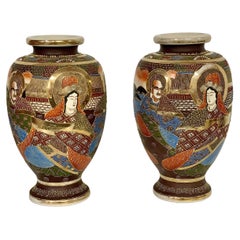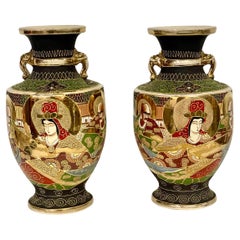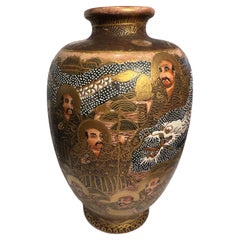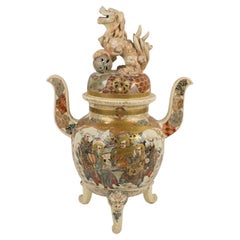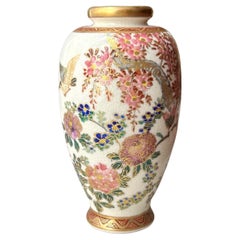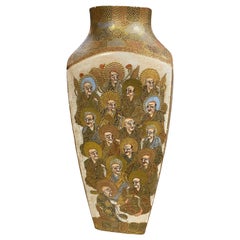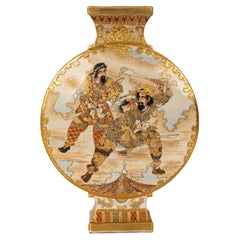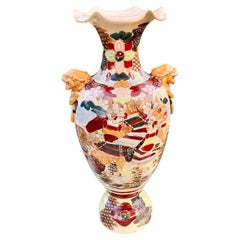Satsuma Asian Art and Furniture
to
6
16
9
28
12
16
6
4
3
3
28
10
6
6
1
22
21
20
1
28
28
28
18
61
55
55
53
Creator: Satsuma
Pair of Japanese Satsuma 'Moriage' Porcelain Gilt Vases
By Satsuma
Located in LA CIOTAT, FR
This handsome pair of 20th century glazed and gilded Japanese Satsuma vases, with their vivid, jewel-like colours and elegant baluster-shaped forms, feature the traditional Japanese ...
Category
20th Century Japanese Satsuma Asian Art and Furniture
Materials
Porcelain
Pair of Early 20th Century Japanese Satsuma Vases
By Satsuma
Located in LA CIOTAT, FR
This exquisite pair of Satsuma vases dates back to the early 20th century. Hand-painted with intricate relief decorations, these ceramic masterpieces showcase exceptional craftsmansh...
Category
20th Century Japanese Satsuma Asian Art and Furniture
Materials
Ceramic
Antique Satsuma One Thousand Faces and Dragon Meiji Period Baluster Shaped Vase
By Satsuma
Located in Tustin, CA
A very exquisite and elaborately detailed collectible antique hand made "A Thousand Faces" Japanese Satsuma earthenware pottery baluster shaped vase features intricately hand painted...
Category
19th Century Japanese Meiji Antique Satsuma Asian Art and Furniture
Materials
Earthenware, Pottery
19th Century Japanese Satsuma Porcelain Water Well Bucket, Wishing Well Vase
By Satsuma
Located in Vero Beach, FL
This Japanese porcelain vase is barrel shaped with a yolk handle. It is both finely and intricately hand painted. It pictures groups of scholars with scrolls dressed in elaborate brocade kimonos...
Category
Late 19th Century Japanese Meiji Antique Satsuma Asian Art and Furniture
Materials
Porcelain
$600 Sale Price
20% Off
Meiji Satsuma Earthenware Urn or Vase with Foo Dog Sculpture, circa 1880
By Satsuma
Located in Atlanta, GA
A magnificent testament to the artistry of the Japanese Meiji period (1868-1912), this rare Satsuma earthenware urn is an extraordinary find. Crafted in Japan circa 1880, its delicat...
Category
Late 19th Century Japanese Meiji Antique Satsuma Asian Art and Furniture
Materials
Earthenware
Meiji Period Diminutive Satsuma Baluster Vase.
By Satsuma
Located in Vero Beach, FL
Meiji Period Diminutive Satsuma Baluster Vase.
This Japanese Satsuma vase from the late Meiji period is hand painted and gilt decorated with a Japanese landscape in exquisite detail...
Category
20th Century Japanese Meiji Satsuma Asian Art and Furniture
Materials
Porcelain
$680 Sale Price
20% Off
Antique circa 1900 Chinese Very Large Earthenware Dragon Planter Plant Egg Pot
By Satsuma
Located in Autonomous City Buenos Aires, CABA
Antique Chinese glazed ceramic egg cup. This brown glazed stoneware urn displays vibrant turquoise tones within. Large egg planter currently being used as ...
Category
Early 1900s Chinese Chinese Export Antique Satsuma Asian Art and Furniture
Materials
Earthenware
Satsuma Imperial Vase "A Thousand Faces" Meiji Period
By Satsuma
Located in Autonomous City Buenos Aires, CABA
Satsuma Imperial Vase "A Thousand Faces" Meiji Period
A Japanese collectible vase, hand painted decorated with intricate designs and figures, with a classic shape and painted with va...
Category
19th Century Japanese Meiji Antique Satsuma Asian Art and Furniture
Materials
Ceramic
Pair of Blue Ground Japanese Satsuma Vases
By Satsuma
Located in Norwood, NJ
These are a very good quality pair of earthenware Japanese Satsuma vases, beautifully hand decorated and from the Meiji period, circa 1920. The vases have a hexangular shape raised o...
Category
Early 20th Century Japanese Meiji Satsuma Asian Art and Furniture
Materials
Ceramic, Earthenware
$2,175 / set
Antique Japanese Satsuma Vase – Hand-Painted Festival Scene with Sculpted Animal
By Satsuma
Located in Bochum, NRW
Antique Japanese Satsuma Vase – Hand-Painted Festival Scene with Sculpted Animal Heads Meiji-Era Masterpiece
A beautiful Chinese 'Nanjing' porcelain baluster vase, intricately decora...
Category
1930s Japanese Meiji Vintage Satsuma Asian Art and Furniture
Materials
Porcelain
Antique Japanese Satsuma Vase, Hand-Painted Warrior Scene, Meiji-Era Masterpiece
By Satsuma
Located in Bochum, NRW
Antique Japanese Satsuma Vase – Hand-Painted Warrior Scene, Meiji-Era Masterpiece.
Japanese Satsuma ceramic vase with polychrome decorations of Japanese men and soldiers in armor. Go...
Category
1930s Japanese Meiji Vintage Satsuma Asian Art and Furniture
Materials
Porcelain
Antique Japanese Satsuma Vase – Hand-Painted Meiji-Era Masterpiece
By Satsuma
Located in Bochum, NRW
Antique Japanese Satsuma Vase – Hand-Painted Meiji-Era Masterpiece
Japanese Satsuma ceramic vase with polychrome decorations of Japanese men and soldiers in armor. Golden details. Ja...
Category
1930s Japanese Meiji Vintage Satsuma Asian Art and Furniture
Materials
Porcelain
Japanese Satsuma Dragon Vase, Meiji Period, c 1900, Japan
By Satsuma
Located in Austin, TX
A fantastic small Japanese Satsuma vase with image of writhing dragons, Meiji Period, circa 1900, Japan.
The vase of elegant baluster form, with a slightly flared foot, slender body...
Category
Early 1900s Japanese Meiji Antique Satsuma Asian Art and Furniture
Materials
Ceramic, Porcelain, Pottery, Stoneware, Hardwood
Antique Japanese Taisho Satsuma Painted Vase
By Satsuma
Located in LA CIOTAT, FR
A petite and beautiful hand-decorated ceramic baluster vase, painted all around with traditional Japanese motifs, including native flora, birds and bamboo stems on a creamy glazed background. The colour palette is bold and bright, with highlights of green, red and blue, together with plentiful gilt relief...
Category
Early 20th Century Japanese Taisho Satsuma Asian Art and Furniture
Materials
Ceramic
Japanese Meiji Period Satsuma Large Square Bowl Centerpiece
By Satsuma
Located in Vero Beach, FL
Japanese Meiji Period Satsuma large square bowl
Antique early Meiji Period 15" square with scalloped rim Satsuma bowl. Highly unusual and finely painted. ...
Category
19th Century Japanese Meiji Antique Satsuma Asian Art and Furniture
Materials
Ceramic
$4,160 Sale Price
20% Off
Satsuma Japanese Meiji Miniature Enameled Teapot Kozon Mark
By Satsuma
Located in Bishop's Stortford, Hertfordshire
An exceptional Japanese Satsuma miniature spool shaped pottery teapot and cover finely hand enameled with Kozon mark and dating from around 1880. This delightful teapot has an invers...
Category
19th Century Japanese Meiji Antique Satsuma Asian Art and Furniture
Materials
Pottery
Early Japanese Satsuma Antique Vase
By Satsuma
Located in Atlanta, GA
An Satsuma ceramic stone ware vase, circa 19th century, around the end of the Edo and the beginning of Meiji period. In the form of a Classic garlic bottle whose prototype was from China, the white bodied piece is decorated with an early form of kin nishikide, the so called golden brocade, a palette of iron-red, blue, green, yellow, purple and black with golden highlight. The over glazed enamel paint shows a group of robed figures in a garden setting with a lion and three tigers. A transparent overall glaze shows very fine crackles. The design is relatively sparse with plenty of negative space in contrast to the Satsuma production from the late 19th century, when the trend became fussy and overly glitz, due to the influence by the perceived western taste for the export market. This piece may still be made for export but its pattern was more influenced by both Kyoto Pottery and the Kano school of painting compared to the export ware by the end of the 19th century onward to the early 20th century. It was believed by many that this was a result of Satsuma potters visiting Kyoto in the late seventeenth century to learn over glaze painting techniques.
There are some age glaze crackles especially around the foot. The piece is not signed in keeping with the earlier production before Satsuma ceramics...
Category
Mid-19th Century Japanese Japonisme Antique Satsuma Asian Art and Furniture
Materials
Ceramic
$2,850 Sale Price
25% Off
Satsuma Japanese Meiji Pair Diamond Shaped Pottery Vases
By Satsuma
Located in Bishop's Stortford, Hertfordshire
A good and unusual pair antique Japanese Satsuma Meiji diamond shaped pottery vases decorated with monk figures with a scrolling dragon dating from the 1...
Category
19th Century Japanese Meiji Antique Satsuma Asian Art and Furniture
Materials
Pottery
Antique Japanese Satsuma Pottery Vase & Lidded Urn, Hand Painted & Gilt, C1920
By Satsuma
Located in Big Flats, NY
Antique Japanese Satsuma Pottery Garden Scene Vase & Lidded Urn, Hand Painted & Gilt, C1920
Measures- Large: 7.25''H x 4.5''W x 4.5''D; Small: 8''H ...
Category
Early 20th Century Asian Satsuma Asian Art and Furniture
Materials
Pottery
$360 Sale Price / set
20% Off
Excellent Satsuma Charger
By Satsuma
Located in Swadlincote, GB
A super quality Satsuma bowl, in overall excellent condtion.
Satsuma china, or Satsuma ware, originates from the Satsuma Province in southern Kyūshū, Jap...
Category
19th Century Japanese Japonisme Antique Satsuma Asian Art and Furniture
Materials
Ceramic
A Japanese Satsuma Earthenware Circular Box and Cover
By Satsuma
Located in West Palm Beach, FL
A Japanese Satsuma earthenware circular box and cover, MEIJI PERIOD (1868-1912), the interior and exterior decorated with gilt and contrasting figural scenes, signed Satsuma yaki se...
Category
20th Century Satsuma Asian Art and Furniture
Materials
Porcelain
Satsuma Earthenware Vase and Cover, Japanese, Meiji Period
By Satsuma
Located in West Palm Beach, FL
A Satsuma Earthenware vase and cover,
Japanese, Meiji period, (1868-1912)
decorated in polychrome enamels and gilt over a clear, crackled glaze, delicately painted with samurai on ...
Category
1890s Antique Satsuma Asian Art and Furniture
Materials
Ceramic
Pair of Satsuma Pedestals, 20th Century
By Satsuma
Located in CABA, AR
Enter the world of Japanese craftsmanship and elegance with this exquisite pair of Satsuma columns or pedestals. Satsuma ware, originating from the Sat...
Category
Mid-20th Century Japanese Satsuma Asian Art and Furniture
Materials
Porcelain
$3,200 Sale Price / set
20% Off
Satsuma Earthenware Flat Shouldered Ovoid Vase, Garlic Mouth by Yabu Meizan
By Satsuma
Located in West Palm Beach, FL
A Satsuma earthenware flat shouldered ovoid vase with garlic mouth by Yabu Meizan,
Osaka, 1853-1934,
decorated in polychrome enamels and gilt over a cle...
Category
1890s Antique Satsuma Asian Art and Furniture
Materials
Earthenware
Japanese Meiji Satsuma Finely Decorated and Gilded Scenic Box
By Satsuma
Located in Sarasota, FL
Japanese Meiji satsuma finely hand decorated and gilded box. The box depicts a different scene on each side. Marked with a maker's mark on the bottom.
Category
Late 19th Century Japanese Meiji Antique Satsuma Asian Art and Furniture
Materials
Pottery
A Japanese Satsuma earthenware circular box and cover
By Satsuma
Located in West Palm Beach, FL
A Japanese Satsuma earthenware circular box and cover,
19th/early 20th century
sealed with Satsuma
Category
20th Century Satsuma Asian Art and Furniture
Materials
Porcelain
Satsuma Earthenware Cabinet Vase, Early 20th Century
By Satsuma
Located in West Palm Beach, FL
Satsuma earthenware cabinet vase, early 20th century. Decorated with immortals, signed.
Height 4.25 in. (10.79 cm.), by 2.5 in. (6.35 cm.)
Category
20th Century Satsuma Asian Art and Furniture
Materials
Ceramic
Satsuma Earthenware Covered Box, by Kinkozan
By Satsuma
Located in West Palm Beach, FL
A Satsuma Earthenware covered box,
by Kinkozan,
Japanese, Meiji period (1868-1912)
decorated in polychrome enamels and gilt over a clear, crackled glaze, delicately painted with s...
Category
Early 1900s Antique Satsuma Asian Art and Furniture
Materials
Earthenware
Related Items
Satsuma Japanese Meiji Miniature Enameled Teapot Kozon Mark
By Satsuma
Located in Bishop's Stortford, Hertfordshire
An exceptional Japanese Satsuma miniature spool shaped pottery teapot and cover finely hand enameled with Kozon mark and dating from around 1880. This delightful teapot has an invers...
Category
19th Century Japanese Meiji Antique Satsuma Asian Art and Furniture
Materials
Pottery
Japanese Antique Satsuma Pottery Buddhist Monks Vase with Shimazu Crest Mark
By Satsuma
Located in Studio City, CA
A beautiful Japanese Satsuma pottery studio vase featuring multiple kesa-clad enlightened Buddhist monks on each side of the vase. The piece is finely detailed with rich raised gilt highlights throughout and beautifully decorated in gold and various hand painted other colors.
From the Meiji period (1868-1912).
This piece has the all-important Shimazu Family crest mark (red circle with a cross inside) on the base authenticating the work as an old and original Satsumaware work. The mark shows the pottery was made under the rule of the Shimazu clan.
From a Los Angeles Collection...
Category
Early 20th Century Japanese Meiji Satsuma Asian Art and Furniture
Materials
Earthenware, Pottery
$1,250
H 11.5 in W 4.5 in D 4.5 in
19th Century Japanese Hand-Painted Blue and White Porcelain Charger Plate
Located in Yonkers, NY
A Japanese porcelain charger plate from the 19th century, with hand-painted blue and white blooming tree, rocky formation and bird décor. Created in Japan during the 19th century, th...
Category
19th Century Japanese Antique Satsuma Asian Art and Furniture
Materials
Porcelain
Japanese Meiji Period (1868-1912) Satsuma Earthenware Vase Taizan for Hattori
Located in Newark, England
Meiji Period (1868-1912)
From our Japanese collection, we are delighted to offer Japanese Meiji Period Satsuma Vases. The Satsuma Vase of hexagonal form with a slight waisted neck and tight rounded rim is extensively decorated with multiple figures to two large scenes. The first scene features a beach with waves to the background and a plethora of figures including multiple geisha holding traditional Japanese wagasa’s. The second scene follows on from the first with a large building in the foreground holding figures on a large platform under a pagoda roof with a pagoda building in the background and further figures in the foreground. The scenes are framed by a full detailed border with gilt shapes, flowers amongst pink shaded backgrounds and butterflies around the neck. The Satsuma Vase is unusually signed Fine Art, Satsuma Ware, Dai Nippon (Great Japan), Hattori Made, Gosuido Works, Taizan Painted. 美術, サツマヤキ(薩摩焼), 大日本, 服部造, 五スイ堂工, 對山画 and dates to the Meiji Period (1868-1912) and the turn of the 20th century circa 1905.
Satsuma ware is a type of earthenware pottery originating from the Satsuma province in Southern Kyushu, Japan’s third largest island.
Wagasa are traditional Japanese umbrellas made of washi paper attached to a bamboo frame and treated to ensure it is waterproof.
Meiji Period was an era of Japanese history that spanned from 1868 to 1912. It was the first half of the Empire of Japan, when the Japanese people began to build a paradigm of a modern, industrialised nation state and emergent great power, influenced by Western countries and aesthetics. As a result of radically different ideas, the changes to Japan were profound and it affected the social structure, politics, economy, military, and foreign relations across the board. The period corresponded to the reign of Emperor Meiji and was preceded by the Keio era and was succeeded by the Taisho era.
Cultural Art during the Meiji Period was of particular interest to the government and they overhauled the art export market which in turn promoted Japanese arts via various world’s fairs, beginning in Vienna at the world fair in 1873. The government heavily funded the fairs and took an active role organising how Japan’s culture was presented to the world including creating a semi-public company named Kiritsu Kosho Kaisha (First Industrial Manufacturing Company). The Kiritsu Kosho Kaisha was used to promote and commercialise exports of Japanese art and established the Hakurankai Jimukyoku (Exhibition Bureau) to maintain quality standards. For the 1876 Centennial International Exhibition in Philadelphia, the Japanese government created a Centennial Office and sent a special envoy to secure space for the 30,000 items that would be displayed. The Imperial Household also took an active interest in arts and crafts, commissioning works by select artists to be given as gifts for foreign dignitaries further emphasising the high quality and importance of Japanese art. Just before the end of the 19th century in 1890, the Teishitsu Gigeiin (Artist to the Imperial Household) system was created to recognise distinguished artists. These artists were selected for their exceptionally high quality wares and talent in their own industry. Over a period of 54 years Seventy artists were appointed, amongst these were ceramicist Makuzu Kozan and cloisonné enamel artist...
Category
Early 1900s Japanese Meiji Antique Satsuma Asian Art and Furniture
Materials
Earthenware, Pottery
$3,181
H 4.63 in W 2.17 in D 2.37 in
Japanese Meiji Period (1868-1912) Satsuma Vase by Kinkozan
By Kinkozan
Located in Newark, England
JAPANESE SATSUMA PROCESSIONAL VASE
From our Japanese collection, we are delighted to introduce to the market this Japanese Satsuma Vase by Kinkozan. The vase with a compressed body ...
Category
Late 19th Century Japanese Meiji Antique Satsuma Asian Art and Furniture
Materials
Ceramic, Earthenware, Pottery
Antique Japanese Meiji Period Satsuma Vase by Ryozan
Located in Newark, England
MEIJI PERIOD 1868-1912
From our Japanese collection, we are delighted to offer this Japanese Satsuma Vase by Ryozan. The vase of tapered form with tightly pinched neck and flared to...
Category
Late 19th Century Japanese Meiji Antique Satsuma Asian Art and Furniture
Materials
Ceramic, Earthenware, Pottery
Pair Antique 19th Century Japanese Imari Porcelain Plates, circa 1890's
Located in New Orleans, LA
Pair antique 19th century Japanese Imari porcelain plates, circa 1890's.
Category
19th Century Japanese Antique Satsuma Asian Art and Furniture
Materials
Porcelain
Antique 19th Century Japanese Satsuma Vase Richly Decorated Marked Base Japan
Located in Amsterdam, Noord Holland
Lovely etailed piece. Marked on base with makers mark and mon crest
Condition
Overall condition perfect. Size: 294mm
Period
Meiji Periode (1867-1912).
Category
19th Century Japanese Meiji Antique Satsuma Asian Art and Furniture
Materials
Earthenware
$859 Sale Price
20% Off
H 11.58 in Dm 0.04 in
Japanese Satsuma Ginger Jar Vase, circa Early 20th Century
Located in New York, NY
A beautiful small Japanese Satsuma ginger jar vase, circa early-20th century, Japan. Colors include cream, copper, green, blue, white, black, orange...
Category
Early 20th Century Japanese Meiji Satsuma Asian Art and Furniture
Materials
Ceramic, Earthenware, Pottery
Japanese Antique Meiji Period Satsuma Vase by Kinkozan
By Kinkozan
Located in Newark, England
GLOBULAR FORM MINIATURE VASE
From our Japanese collection, we are delighted to offer this Japanese Satsuma Vase by Kinkozan. The Satsuma Vase made from earthenware pottery is potted...
Category
Early 1900s Japanese Meiji Antique Satsuma Asian Art and Furniture
Materials
Ceramic, Earthenware, Pottery
Pair of Antique Japanese Satsuma Vase Japanese Satsuma Ware Lovely Ladies
Located in Amsterdam, Noord Holland
Fabulous Japanese vases with an all around scene of lovely ladies, 19th century.
Marked at base,
?? Yasui
Condition
Overall condition vase 1 perfect, just some minimal enamel...
Category
19th Century Japanese Meiji Antique Satsuma Asian Art and Furniture
Materials
Earthenware
$1,623 Sale Price
20% Off
H 4.93 in Dm 0.04 in
Pair of Blue Ground Japanese Satsuma Vases
By Satsuma
Located in Norwood, NJ
These are a very good quality pair of earthenware Japanese Satsuma vases, beautifully hand decorated and from the Meiji period, circa 1920. The vases have a hexangular shape raised o...
Category
Early 20th Century Japanese Meiji Satsuma Asian Art and Furniture
Materials
Ceramic, Earthenware
Previously Available Items
Antique Japanese Meiji Period Satsuma Pottery Moon Flask Vase Samurai 1880
By Satsuma
Located in Portland, OR
A magnificent antique Japanese Meiji period Satsuma pottery moon flask vase, circa 1880.
The vase is very skillfully hand-painted in polychrome enamels and gilt decoration, it is of ...
Category
1880s Japanese Meiji Antique Satsuma Asian Art and Furniture
Materials
Pottery
H 12.25 in W 8.5 in D 2 in
Satsuma Polychrome Painted Vase, Taisho Period (1912- 1926)
By Satsuma
Located in New Orleans, LA
An early 20th century antique Japanese Taisho Period Satsuma vase, with hand painted moriage (raised paint) fighting Samurai warriors on one side and a floral scene on the reverse. T...
Category
1910s Japanese Taisho Vintage Satsuma Asian Art and Furniture
Materials
Ceramic
Museum Quality Antique Japanese Satsuma Signed by Kinkozan, Meiji Era
By Satsuma
Located in London, GB
A museum quality satsuma miniature pear single-stem vase.
By Kinkozan, Meiji era (1868-1912), late 19th century.
Decorated in predominantly in gold enamels with a writhing three-cl...
Category
Late 19th Century Japanese Antique Satsuma Asian Art and Furniture
Materials
Ceramic
Pair of Japanese Satsuma Kutani Porcelain Foo Dogs Sculptures/Figurines
By Satsuma
Located in Guaynabo, PR
This is a pair of Japanese Satsuma Kutani porcelain Foo Dogs. They are hand painted white and adorned with gilt and silver suns, flowers and scrolls. Bo...
Category
20th Century Japanese Chinoiserie Satsuma Asian Art and Furniture
Materials
Porcelain
Satsuma Edo Period Gosu Blue Vase with Shimazu Mon Signature
By Satsuma
Located in Delft, NL
Satsuma Edo period Gosu blue vase with Shimazu Mon signature
With high relief water dragon wraps around the vase
Gosu blue is a glaze enamel on Satsuma "...
Category
19th Century Japanese Antique Satsuma Asian Art and Furniture
Materials
Earthenware
Pair of Large, Meiji Period, Japanese Satsuma Vases with Opulent Gilt
By Satsuma
Located in Vero Beach, FL
Presenting a superb pair of Japanese Satsuma vases. They are crafted with high quality workmanship and unsurpassed gilding. The decorations are extremely detailed and the panels are ...
Category
Early 20th Century Japanese Meiji Satsuma Asian Art and Furniture
Materials
Porcelain
Pair of 19th Century Satsuma Vases
By Satsuma
Located in London, GB
Each one hand painted with a different cartouche of ladies amusing themselves at Court. The backs of the vases are equally heavily decorated with country and mountain scenes whilst t...
Category
Late 19th Century Japanese Meiji Antique Satsuma Asian Art and Furniture
Materials
Porcelain
Late 19th Century Pair of Japanese Satsuma Vases
By Satsuma
Located in Paris, FR
Pair of baluster-shaped vases painted in polychrome enamels and gold. The paunch is decorated with two panels depicting samurai, the reverse with Japanese courtiers, the neck and the shoulder with stylised flowers and other geometric patterns. Satsuma, Japan. Meiji period (1868-1912). Good vintage condition.
Satsuma ware (Satsuma-yaki) is a type of Japanese pottery originally from Satsuma Province, southern Kyushu. Today, it can be divided into two distinct categories: the original plain dark clay early...
Category
Late 19th Century Japanese Japonisme Antique Satsuma Asian Art and Furniture
Materials
Enamel
Japanese Meiji Period Satsuma Incense Burner, Koro
By Satsuma
Located in Austin, TX
A finely painted Satsuma incense burner, or koro, with original silver cover.
The lobed body of quatrefoil form, painted in relief in typical S...
Category
19th Century Japanese Meiji Antique Satsuma Asian Art and Furniture
Materials
Silver, Enamel
Japanese Porcelain Center Bowl
By Satsuma
Located in Los Angeles, CA
1900 - 1930's Very Fine Large Japanese Porcelain Center Bowl. Gilded and Hand Painted. Signed by Satsuma.
Category
1930s Japanese Vintage Satsuma Asian Art and Furniture
Materials
Porcelain
Japanese Mid - 20th century Satsuma Tea/Coffee set
By Satsuma
Located in Firenze, IT
Consisting of everything you need to serve tea or coffee. This beautifully hand-painted fine porcelain tea/coffee service with its decorations "Kozan" (1842-1916) and its gold leaf a...
Category
19th Century Japanese Antique Satsuma Asian Art and Furniture
Satsuma asian art and furniture for sale on 1stDibs.
Satsuma asian art and furniture are available for sale on 1stDibs. These distinctive items are frequently made of ceramic and are designed with extraordinary care. There are many options to choose from in our collection of Satsuma asian art and furniture, although brown editions of this piece are particularly popular. If you’re looking for additional options, many customers also consider asian art and furniture by Ando Jubei, Makuzu Kozan, and Kinkozan. Prices for Satsuma asian art and furniture can differ depending upon size, time period and other attributes — on 1stDibs, these items begin at $580 and can go as high as $13,500, while a piece like these, on average, fetch $1,825.
Creators Similar to Satsuma
Questions About Satsuma Asian Art and Furniture
- 1stDibs ExpertApril 5, 2022Satsuma porcelain or pottery includes a maker’s mark with the name of the person who made the item. Japanese numbers may also indicate that a Satsuma piece was part of a collection. Genuine Satsuma pieces will not have a “Made in Japan” label and should only include Japanese characters. When in doubt, work with a certified appraiser to determine the authenticity of your Satsuma piece. Find a variety of expertly vetted Satsuma porcelain and pottery collectibles on 1stDibs.
- Is Satsuma pottery valuable?1 Answer1stDibs ExpertApril 26, 2024Yes, some Satsuma pottery is valuable. The age, type, style and condition will determine how much a particular piece is worth. In addition, the history of ownership may also make a piece more valuable. For example, if a piece was previously in the collection of a notable person, such as a member of the Japanese Imperial Family, it may be worth more. To get an estimated value for a particular piece, consult a certified appraiser or knowledgeable antiques dealer. Find a range of Satsuma pottery on 1stDibs.
- 1stDibs ExpertOctober 7, 2024The difference between Satsuma and moriage is that the former is a type of pottery, and the latter is a technique for decorating pottery. Satsuma pottery is the term for earthenware pottery from Japan's Satsuma region. Although there are different styles, the most common element of Satsuma pottery is a heavy, dark glaze. Moriage is the term for when potters add raised slip decorations to pottery, creating a three-dimensional effect. Some Satsuma pieces show off moriage details, while others do not. Shop a range of Satsuma pottery on 1stDibs.
- How do I date a Satsuma vase?1 Answer1stDibs ExpertMarch 22, 2022To date a Satsuma vase, study its mark. Vases made before World War II normally feature a mark in Japanese. A vase that says "Royal Satsuma" likely dates back to the late 20th century. You'll find a variety of expertly vetted Satsuma vases on 1stDibs.
- What is a Japanese Satsuma vase?1 Answer1stDibs ExpertOctober 12, 2021A type of Japanese pottery originated from Satsuma province in Japan is termed as Satsuma ware. A vase of this kind is known as a Satsuma vase. An interesting fact about Satsuma ware is that they feature a "makers mark" or marking as a key to help collectors unlock the value, age and authenticity of the piece. Shop a range of antique and vintage Japanese vases on 1stDibs.
- 1stDibs ExpertNovember 4, 2024To identify Satsuma pottery marks, you'll typically need to perform research using trusted online resources. Satsuma is a region in Japan known for its pottery, and many factories and artisans have operated there, including Kinkozan, Taizan, Yasuda, Choshuzan, Fuzan, Gyozan, Koshida and Maruni Kobe. Each maker has its own marks associated with it, and these typically are in Japanese kanji characters. You can compare the characters on your piece to pictures shared online to find a match. Alternatively, a certified appraiser or experienced antique dealer can help you identify your pottery markings. On 1stDibs, shop a selection of Satsuma pottery.
- 1stDibs ExpertFebruary 1, 2024One way to tell if your Satsuma vase is valuable is to look for markings on it. The oldest and typically most expensive pieces will usually have the Shimazu family crest — a circle with a cross through it — hand-painted on the bottom. If the piece is stamped with the marking or says "Made in Japan" in the Roman alphabet, it is a newer vase. Factors like the style of the vase and its condition will also impact its price. It's a good idea to have a certified appraiser or knowledgeable dealer evaluate your vase to determine its value. Find a variety of Satsuma vases on 1stDibs.
- 1stDibs ExpertSeptember 9, 2024Yes, some Satsuma pottery is worth something. Depending on their age, maker, type, style, condition and other factors, pieces may sell for a few hundred to several thousand dollars. Looking at sales and auction histories can give you a rough idea of the value of a piece. For a more definitive valuation, use the services of a certified appraiser or knowledgeable antique dealer. On 1stDibs, explore a collection of Satsuma pottery.
